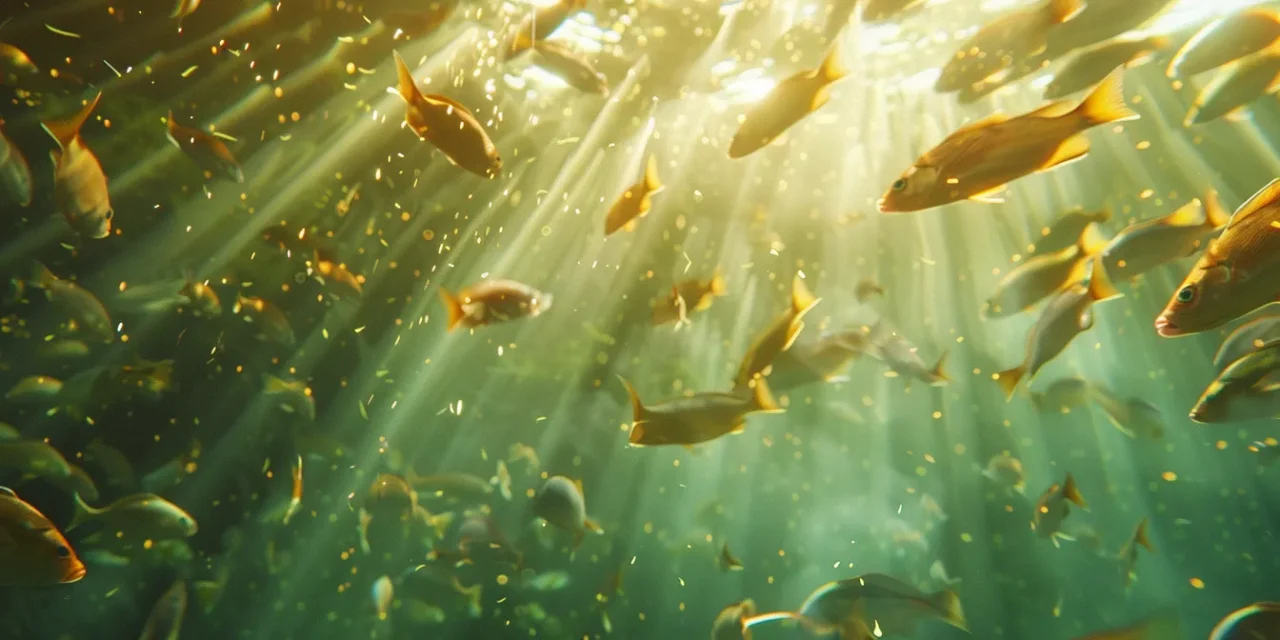Table Of Contents:
- Understanding Fish Poop: A Guide to Your Aquarium’s Health
- The Different Types of Fish Poop and Their Meanings
- Identifying Healthy Fish Excrement in Your Tank
- Signs of Illness Shown Through Changes in Poop
- The Role of Diet in Altering Fish Waste Appearance
- How to Use Fish Poop to Assess Aquarium Health
- Analyzing Poop Consistency for Water Quality
- The Link Between Fish Waste and Ammonia Levels
- Using Waste Accumulation Spots to Identify Filtration Issues
- The Impact of Overfeeding on Fish Excretion
- Understanding the Direct Correlation Between Diet and Poop
- Spotting the Signs of Overfeeding Through Waste
- Adjusting Feeding Routines to Control Waste Production
- Cleaning Techniques for Fish Poop Management
- Effective Vacuuming Strategies for Substrate
- Beneficial Bacteria and Their Role in Breaking Down Fish Waste
- Schedule Planning for Regular Waste Removal
- The Connection Between Fish Poop and Tank Mates
- Species-Specific Waste Patterns and What They Indicate
- How Tank Mates Can Influence Each Other’s Waste Production
- Adjusting Tank Populations for Balanced Waste Management
- Tools and Equipment for Monitoring Fish Waste
- The Best Tools for Removing Fish Poop From Your Aquarium
- Using Water Testing Kits to Assess the Impact of Fish Waste
- Innovative Tech Gadgets for Tracking Aquarium Health Through Waste
- Conclusion
Understanding Fish Poop: A Guide to Your Aquarium‘s Health
Aquarium enthusiasts often overlook a critical indicator of their tank‘s health: fish poop. Just like the guppy flashes its vibrant colors, its waste offers vital signs about water quality, indicating levels of ammonia and nitrite — two compounds you don’t want in excess. Observing these subtle underwater replies can be as easy as using a sponge filter to capture and analyze the excrement. In this article, you’ll learn the ins and outs of fish poop analysis. We’ll provide you with the knowledge to keep your aquatic habitat pristine and your finned friends healthy.
The Different Types of Fish Poop and Their Meanings
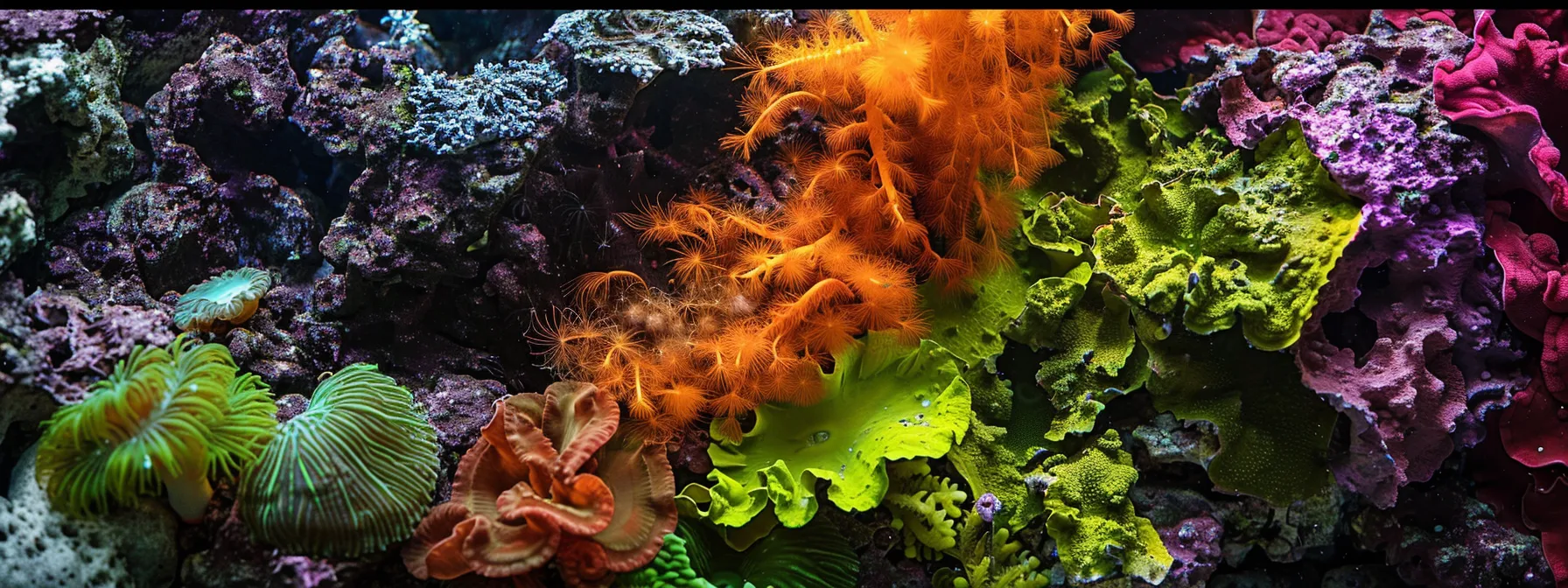
As an aquarist, spotting the difference between various types of fish excrement is crucial for maintaining a healthy ecosystem in your tank. I attentively observe the usual hues and textures of healthy fish waste, knowing that they play an integral part in the biochemistry of my aquarium. For instance, a balanced diet often results in a dark, solid waste that shrimp in the tank might even find appetizing. Shifts in poop color or consistency can ring alarm bells, hinting at potential health issues that may require immediate attention. Also, considering the food I provide, from high-protein snacks to plant-based flakes, has a direct influence on the appearance of their waste. In the daily maintenance routine, I make certain to routinely inspect the substrate and utilize a specialized aquarium vacuum to keep the environment pristine, much like reviewing lines of javascript for errors; meticulous and methodical. It’s this kind of relentless scrutiny and action that supports the vibrant life bustling within the glass walls of my aquarium.
Identifying Healthy Fish Excrement in Your Tank
When I posted the last update on our aquatic community, I highlighted how parrotfish excrement can contribute significantly to soil composition on coral reefs; in a home aquarium, monitoring the poop can be equally telling. Healthy fish waste is typically firm and will break apart easily upon contact with the gravel, where it naturally releases beneficial compounds like potassium. As I ensure my tank‘s fertility, observing the quality and composition of the poop amidst the underwater landscape is as integral as any water quality test.
Signs of Illness Shown Through Changes in Poop
Subtle shifts in the waste of my aquarium dwellers often foretell an underlying issue demanding immediate intervention: the presence of stringy or discolored feces might indicate an infection, whereas excessively pale or clear waste signals malnutrition. Detritus accumulating unnaturally could alter the nitrogen cycle, thereby impacting the delicate balance of nitrate levels in the water – a scenario all too risky for the welfare of the tank’s inhabitants. I’m mindful that waste management is the root of a clear, thriving aquatic environment, so keeping an eye on these signals among the grains of sand leads to timely care and harmony within my marine sanctuary.
- Examining fish poop consistency for signs of illness.
- Acting on changes to prevent a spike in nitrogen and nitrate levels.
- Maintaining tank health by monitoring and reacting to detritus buildup.
The Role of Diet in Altering Fish Waste Appearance
In the realm of fishkeeping, a fish‘s diet directly influences the waste it produces; a diet rich in leafy greens can yield a different waste profile compared to a protein-heavy regimen. Feeding my fish a variety of foods ensures waste that’s not only easier for the planted tank‘s ecosystem to break down but also maintains the water chemistry, reducing the need to constantly adjust with tap water and chemical balancers. Carefully calibrated feeding with a mind towards carbon intake and output is the linchpin in managing my aquatic charges’ health and, by extension, their waste.
- Scrutinize fish waste for consistency and color changes as health indicators.
- Respond to alterations in waste to maintain water quality and prevent toxic buildup.
- Use diet as a tool to fine-tune waste output for optimum tank conditions.
Understanding the various types of fish waste can reveal much about their well-being. Let’s now explore how assessing fish poop can be a window into the overall health of your aquarium.
How to Use Fish Poop to Assess Aquarium Health
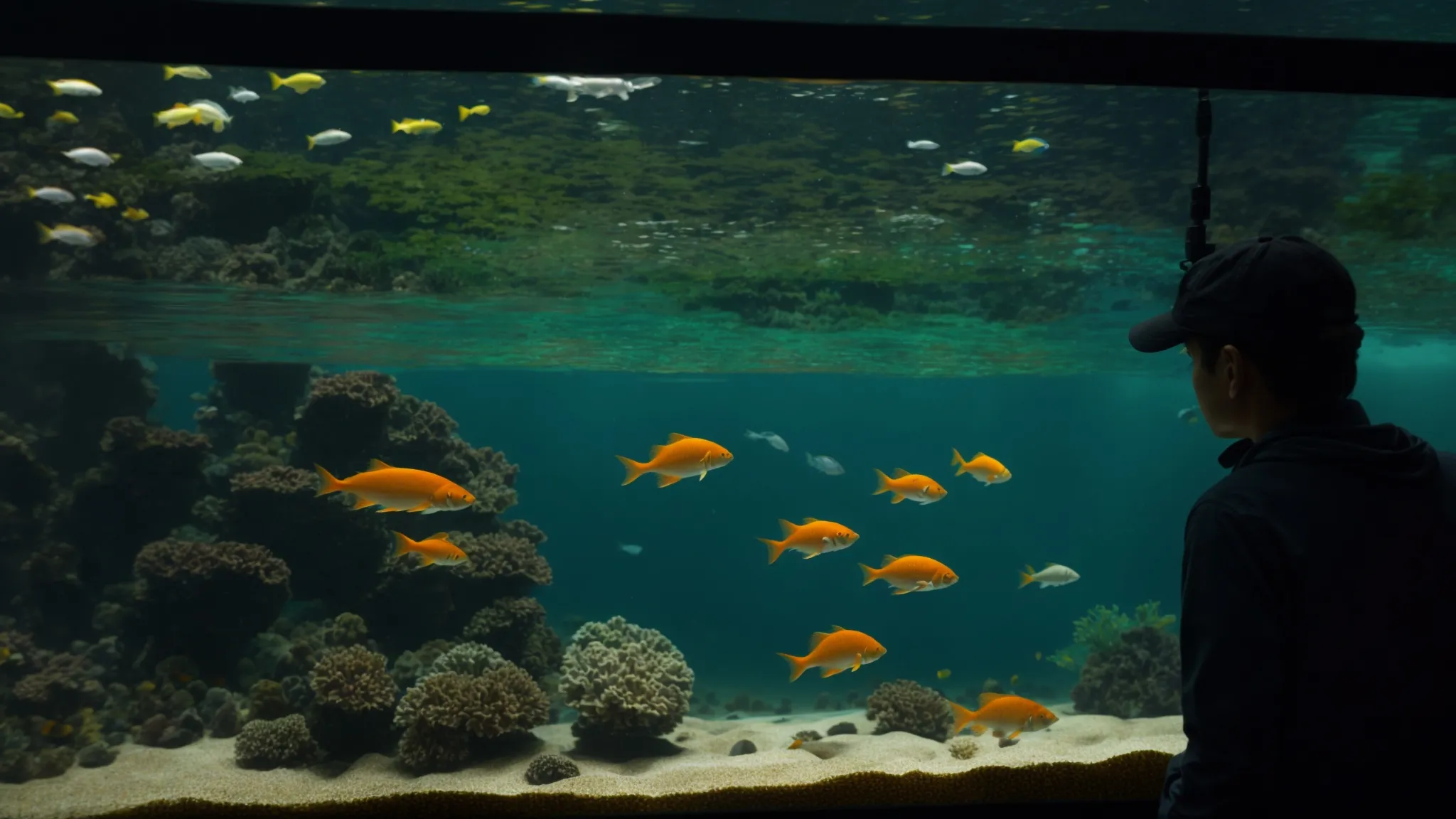
As I deepen my understanding of my aquatic ecosystem, I recognize that analyzing the consistency of fish excrement is instrumental to determining the overall water quality. Just as chefs monitor their menu log for quality control, I track the waste attributes – noting any changes that might impact my tank‘s health. It’s not unlike a closed-loop system, where fish poop plays a vital role, almost akin to how oxygen is crucial for photosynthesis in an aquaponics setup. Monitoring the correlation between fish waste and ammonia levels helps me discern the well-being of different species inhabiting my aquarium. Additionally, by identifying where waste accumulates, I can troubleshoot potential filtration issues, ensuring that every life form in my tank thrives in a clean and balanced aquatic environment.
Analyzing Poop Consistency for Water Quality
Assessing the consistency of fish waste is fundamental to evaluating the quality of water in my aquarium. A sighting of cichlid or tetra waste that’s too soft or disintegrates too quickly can be a red flag, often suggesting a deficiency in dietary magnesium or an imbalance in the water chemistry. Conversely, when detritivores in the tank fail to process the waste effectively, it’s a sign that I need to inspect the ecosystem for nutrient balance and effective filtration.
- Investigate waste consistency from different fish species, like cichlids and tetras.
- Examine the diet’s influence on waste composition, considering magnesium sufficiency.
- Monitor detritivore activity, ensuring they fulfill their role in waste breakdown.
The Link Between Fish Waste and Ammonia Levels
In my routine observations, the direct link between fish waste and ammonia levels in my tanks is unmistakable; waste decomposing without proper filtration releases ammonia, which can be lethal to the aquatic life. To counter this, my filters play a pivotal role in transforming waste into energy for coral and beneficial bacteria, thus maintaining the delicate balance that keeps my tanks flourishing.
Using Waste Accumulation Spots to Identify Filtration Issues
Observing where waste accumulates in my aquarium offers clues about the effectiveness of the filtration system. Spots where organic matter tends to gather could indicate that the filters aren’t capturing all of the feces and leftover food—a key source of nutrients that, if not managed, may turn into harmful substances much like in the ocean, where unmanaged build-up leads to dead zones.
- Inspect areas where fish feces and organic matter accumulate.
- Evaluate the filtration system’s efficacy in those specific spots.
- Adjust or upgrade filtration as necessary to manage nutrient levels and prevent harm.
Evaluating aquarium health through fish waste is just the tip of the iceberg. Now, let’s delve into how overfeeding your aquatic pets can drastically alter their waste production and overall tank wellbeing.
The Impact of Overfeeding on Fish Excretion
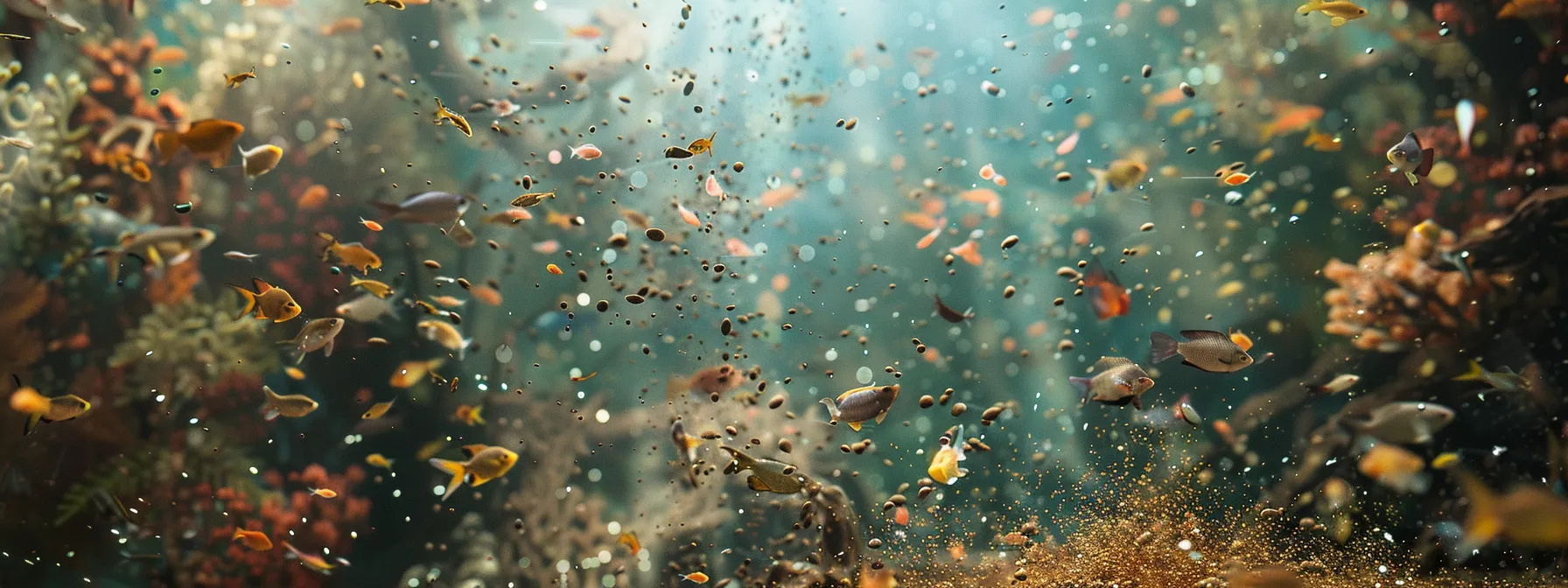
In the delicate balance of reef ecosystems, I’ve come to understand that my actions above the waterline have profound effects below. The correlation between what my fish consume and the waste they produce is irrefutable, with the diet acting as the limiting factor in maintaining ecological stability. Vigilance in spotting the subtler indicators of surplus—such as a spike in waste—alerts me to the need for moderation. Reducing feedings not only controls waste production but also guards against undesirable algae blooms that could outcompete essential bacteria and phytoplankton, pivotal for a healthy aquatic system. In parallel to how climate change prompts us to reconsider our consumption patterns on land, I adjust feeding schedules in my tank to foster an optimum environment for all inhabitants.
Understanding the Direct Correlation Between Diet and Poop
In managing an aquarium, one must recognize how general feeding practices influence not just the well-being of fish, but also their waste which in turn affects the entire tank system. When I overfeed, fish feces accumulate excessively, which, if not addressed, can deteriorate water quality – despite the potential of fish feces serving as fertilizer when balanced correctly. Furthermore, other species like snails can feel the impact, as their roles in breaking down waste are strained, upsetting the natural cycle of the aquarium where waste could otherwise act as a beneficial fertilizer for plant life.
- Assess feeding habits to avoid excessive fish feces accumulation.
- Consider the role of waste as potential fertilizer in a balanced system.
- Be cognizant of how overfeeding affects other detritivores like snails.
Spotting the Signs of Overfeeding Through Waste
Observing the base of my reef aquarium, I detect the grim signs of overfeeding, not just in the growing mound of uneaten food but also in the thickening layers of fish waste. Without swift and decisive use of a siphon, the excess can foment disease, taxing my filtration system beyond its limits. The overabundance of waste serves as an urgent reminder of the delicate balance disrupted by overfishing in natural habitats and the need for responsible feeding practices in controlled aquatic environments.
Adjusting Feeding Routines to Control Waste Production
My experience has shown that a delicate balance is essential when feeding the aquatic animals in my care. By establishing a disciplined feeding routine that matches the consumption needs of the fish population, I effectively reduce the production of waste, high in phosphate, which can otherwise inhibit plant growth in the tank. It’s about striking a precise equilibrium; providing enough food for the animals, yet preventing any excess that could compromise the aquarium‘s health.
Now that we’ve explored how overfeeding can affect your fish‘s waste output, let’s shift our focus to practical methods for managing and cleaning up after these underwater inhabitants. With proper techniques, maintaining a pristine aquatic environment for your finned friends becomes a breeze.
Cleaning Techniques for Fish Poop Management
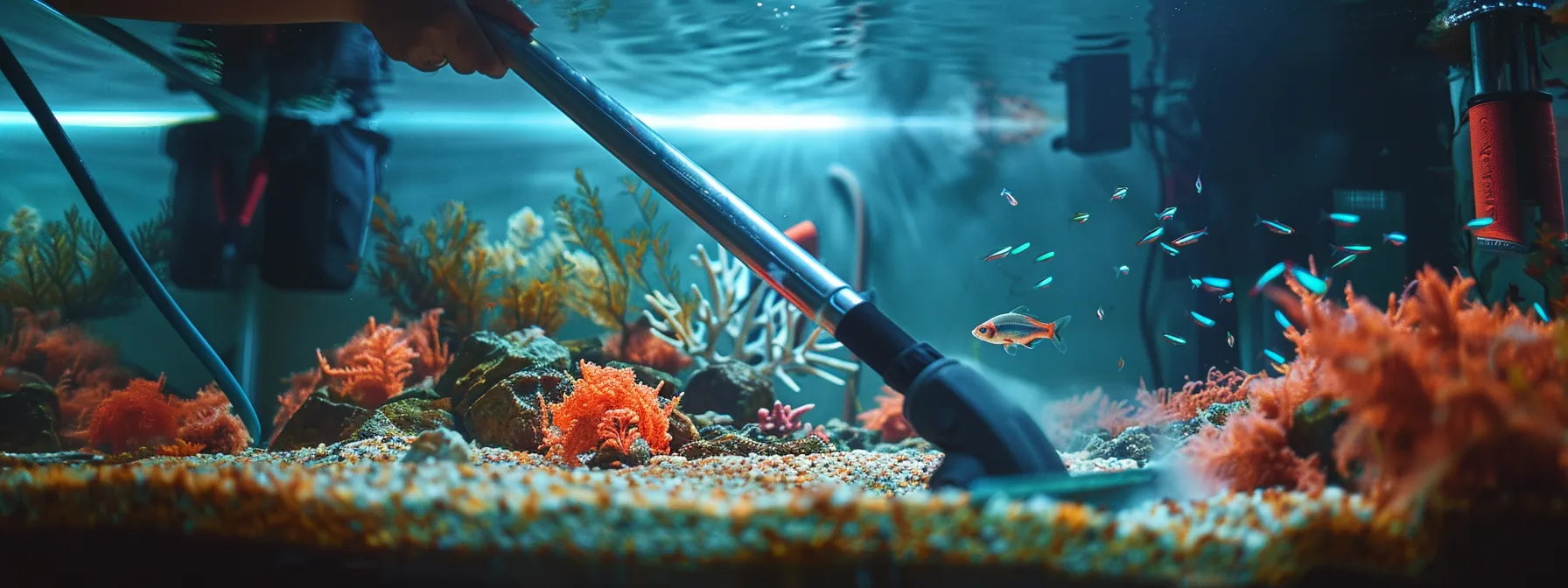
Managing fish excrement is as vital to an aquarium‘s health as corals are to a reef‘s vitality. Iron, calcium, and other micronutrients, integral for the vibrant life of a coral reef, must be meticulously balanced within the tank to maintain an optimal state of health. I’ve found that effective vacuuming of the substrate not only keeps the tank looking pristine, but also protects these essential elements by preventing waste build-up that can bind them. Moreover, fostering a thriving population of beneficial bacteria aids in the breakdown of fish waste, acting as natural recyclers that transform detritus into nutrients. To safeguard the equilibrium of my aquarium‘s ecosystem, I adhere to a carefully planned schedule for waste removal, ensuring that this unglamorous yet critical task is performed consistently, maintaining the clarity and quality of the environment my aquatic friends call home.
Effective Vacuuming Strategies for Substrate
Maintaining a substrate free of fish poop is a delicate task; I use a siphon with a fine tip to gently tease the waste from the nooks and crannies. This method ensures that the tissue of sensitive plant life and the microenvironments of algae are not disrupted. It’s a nuanced approach akin to the care taken by divers around coral reefs, allowing me to safeguard the balanced underwater worlds within my tank.
Beneficial Bacteria and Their Role in Breaking Down Fish Waste
In my aquarium, the inclusion of beneficial bacteria is analogous to deploying microscopic cleanup crews after a shark feeding frenzy; they expertly break down accumulations of fish waste into less harmful substances. These bacterial colonies are essential allies in mitigating the impact of waste on the climate within the tank, converting nitrites to nitrates and ultimately to nitrogen gas, thereby helping to maintain a balanced aquatic ecosystem.
Schedule Planning for Regular Waste Removal
Adhering to a regular schedule for the removal of fish waste is fundamental for the health of my aquarium. I find that setting weekly reminders for partial water changes and substrate cleaning ensures that my aquatic environment remains balanced and vibrant, preventing the build-up of harmful substances. Continuous, diligent maintenance in this fashion is indispensable for creating an ideal habitat for my fish to thrive.
Managing fish waste goes beyond mere cleaning; it’s vital for the welfare of all aquatic dwellers. Let’s now investigate how fish excrement directly impacts the harmony and health of tank mates.
The Connection Between Fish Poop and Tank Mates
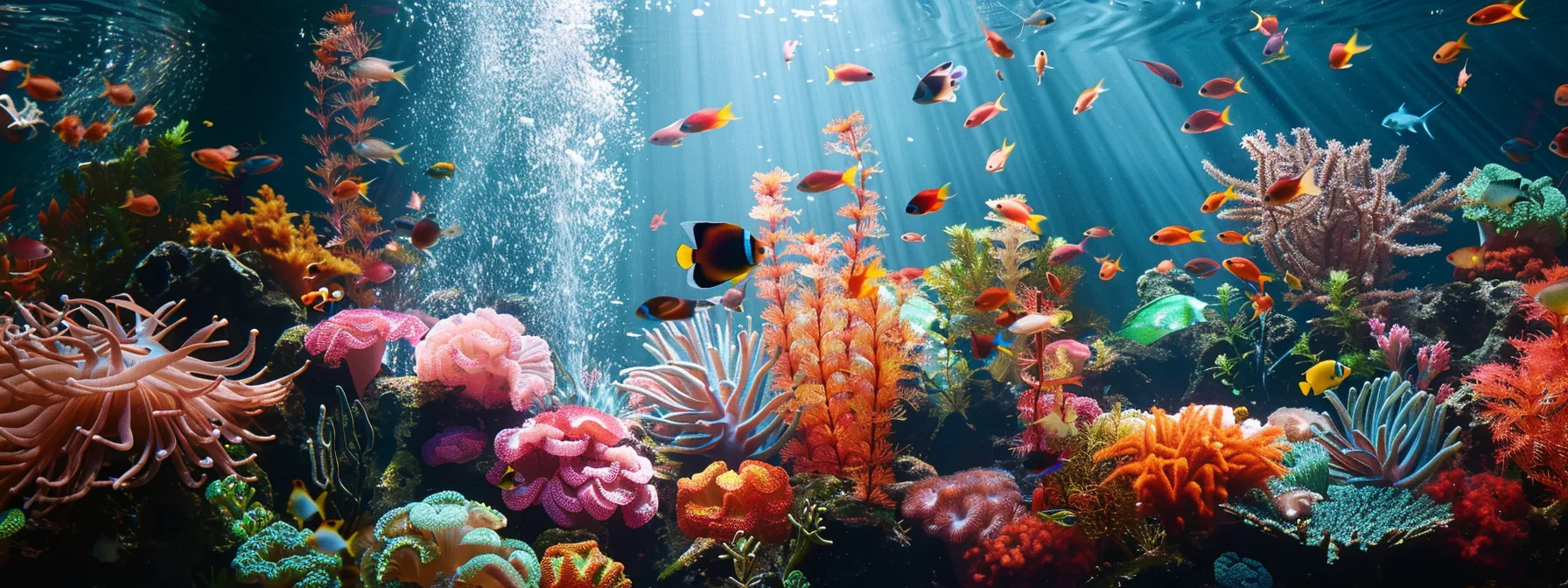
Attuning to the nuances of waste produced by the myriad species in my aquarium is more than a routine check; it’s an investigation into the well-being of my aquatic ecosystem. Each inhabitant exhibits distinct waste patterns reflecting their health and dietary habits. I’ve learned that the presence of certain fish can alter the digestion and waste output of others, revealing an intricate web of interactions beneath the water‘s surface. As a diligent aquarist, I consider the composition of the tank community carefully, aiming to foster a waste production cycle that mirrors a natural balance, much like meticulously curating a botanical garden for optimal growth and harmony among its plant species.
Species-Specific Waste Patterns and What They Indicate
My observations have taught me that the waste produced by different species in my aquarium varies significantly, providing insights into their individual diets and digestive health. For example, if my plecostomus starts producing less waste than normal, it could be a sign of dietary insufficiency or an issue with its environment that demands a thorough investigation and swift action to rectify.
How Tank Mates Can Influence Each Other’s Waste Production
In my experience maintaining aquariums, I’ve found that waste production is significantly influenced by the dynamic interactions within a community of tank mates. For instance, assertive species may outcompete shy feeders for food, leading to unequal waste distribution throughout the habitat. Conversely, a well-structured community with varied diets promotes a natural waste cycle and keeps excessive bioload in check, which is critical for a well-functioning ecosystem.
Adjusting Tank Populations for Balanced Waste Management
Striking a balance in the tank‘s population is a delicate art; overcrowding can lead to excessive waste that upsets the biological filter and water chemistry. By judiciously selecting and spacing the introduction of new species, I strive to maintain equilibrium in waste production, ensuring no single species bears the brunt of maintaining the tank‘s cleanliness or inadvertently creating a hostile environment for others.
Maintaining a healthy aquarium ecosystem hinges on monitoring the outcome; fish waste. Let’s look at the necessary tools and equipment that keep these aquatic environments pristine.
Tools and Equipment for Monitoring Fish Waste
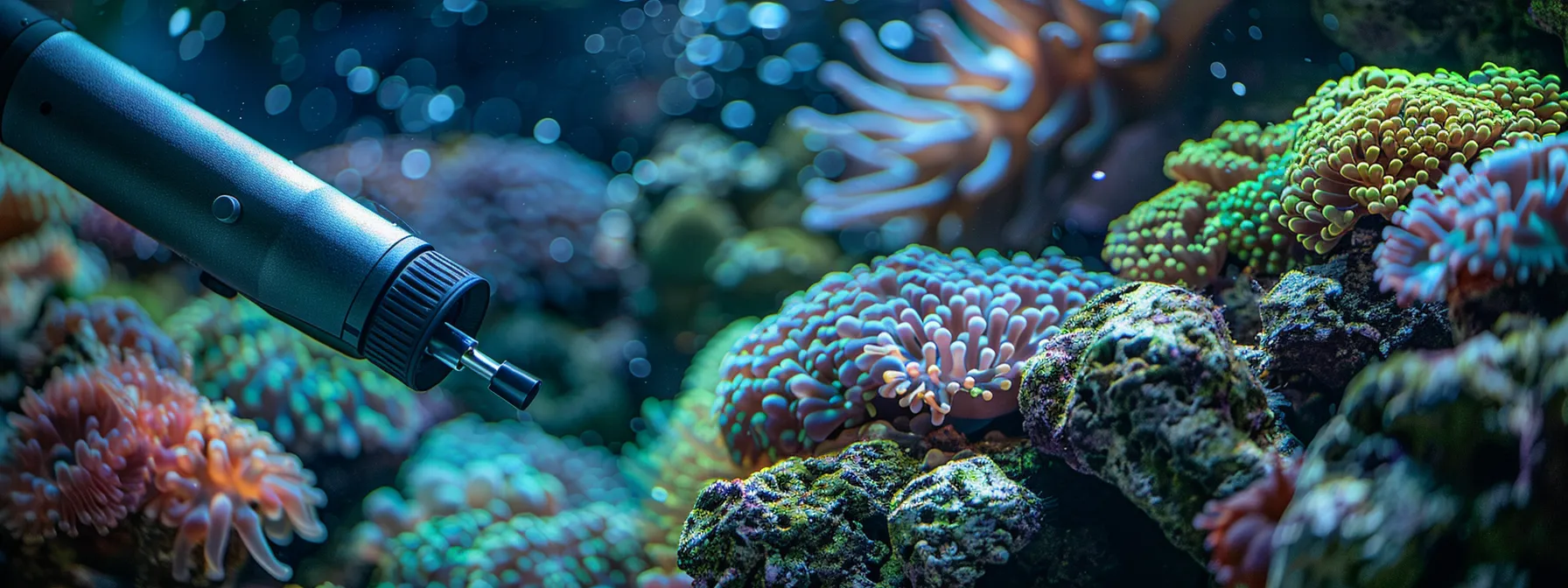
Ensuring the cleanliness of my aquarium and the health of its inhabitants requires more than a keen eye – it necessitates the right set of tools and technology. Whether it’s deploying precise instruments to extract the unwanted debris or utilizing water testing kits for gauging the ecosystem’s responses, the equipment I choose forms the backbone of my maintenance strategy. Advances in technology have even introduced gadgets that allow me to track changes in water quality contributed by fish waste, empowering me to preempt issues before they escalate into bigger problems. My commitment to maintaining a healthy aquarium is bolstered by these tools, and together we work in tandem to create a balanced and thriving aquatic environment.
The Best Tools for Removing Fish Poop From Your Aquarium
For adept removal of fish waste from my aquarium, I rely on a powerful and reliable gravel vacuum; an essential piece of equipment that gently but thoroughly extracts debris from the substrate while preserving the beneficial microfauna. When waste demands more targeted removal, a turkey baster proves invaluable for spot-cleaning or accessing harder-to-reach areas without disturbing the tank‘s inhabitants or their delicate habitats.
Using Water Testing Kits to Assess the Impact of Fish Waste
In my aquarium care arsenal, water testing kits are indispensable for gauging the effects of fish waste on aquatic health. By regularly measuring parameters such as ammonia, nitrate, and phosphate levels, I can determine how efficiently waste is being processed within the ecosystem: an essential practice for preventing toxicity.
- Establish baselines and track changes in water quality using test results.
- Identify imbalances in the tank‘s biofilter system indicated by test readings.
- Take preemptive measures to rectify any detected issues based on water parameters.
Innovative Tech Gadgets for Tracking Aquarium Health Through Waste
Embracing the intersection of technology and aquaculture, I’ve incorporated smart monitors into my routine, devices that continuously sample water for shifts in quality due to fish waste. These systems send alerts to my phone, allowing me to adjust feeding or filtration to preempt imbalance, ensuring my aquatic charges remain in a stable and healthy environment.
Conclusion
Understanding the diverse characteristics of fish waste within an aquarium offers critical insights into the health and diet of the inhabitants. By observing changes in excrement, aquarists can detect and address potential health issues early, ensuring a balanced ecosystem. Regular maintenance and appropriate feeding practices help manage waste production, which is essential for maintaining water quality and preventing toxicity. Utilizing tools and technology for effective waste removal and water analysis further supports a thriving aquatic environment.

